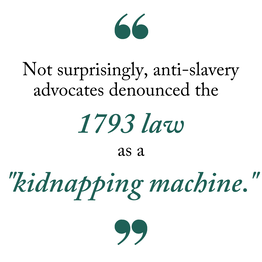|
Prior to the American Revolution there was no provision to compel any North American colony to capture and return fugitive slaves from another colony. English court decisions and opinions came down on both sides of the issue. Some clarity was achieved with the 1772 decision in Somerset versus Stewart. Charles Stewart purchased the enslaved James Somerset in the colonial city of Boston. Stewart brought Somerset to England in 1769 but two years later Somerset escaped. He was recaptured and Stewart had him imprisoned on the ship Ann and Mary and directed that Somerset be sold to a plantation. Somerset's three godparents filed a writ of habeas corpus before the Court of the King’s Bench, which had to determine whether his imprisonment was lawful. The court narrowly held that, “ A master could not seize a slave in England and detain him preparatory to sending him out of the realm to be sold and that habeas corpus was a constitutional right available to slaves to forestall such seizure, deportation and sale because they were not chattel, or mere property, they were servants and thus persons invested with certain (but certainly limited) constitutional protections”. The Somerset judgment did not affect the colonies directly but the Somerset precedent was a warning to American slaveholders. On September 9, 1776, the Continental Congress formally declared the name of the new nation to be the “United States of America”. The Continental Congress had little interest in addressing either the slave trade or fugitive slaves. The Northwest Ordinance adopted in 1787 provided a method for admitting new states to the Union, subsequently Ohio, Indiana, Illinois, Wisconsin and Michigan. Article 6 of the Ordinance declared that there shall be neither slavery nor involuntary servitude in the territory. However, it clearly stated that any person escaping into the territory from whom labor or service is lawfully claimed in any one of the original states may be lawfully returned to the person claiming his or her labor or service. Thus the language of the ordinance prohibited slavery but also contained a clear fugitive slave clause as well.  In autumn 1787 The Articles of Confederation evolved into the Constitution. The status of slavery in the United States was a major impediment to ratification and resulted in the first of many debates and constitutional compromises. What emerged from their deliberations was the Fugitive Slave Clause in Article IV, Section 2: No Person held to Service or Labour in one State, under the Laws thereof, escaping into another, shall, in Consequence of any Law or Regulation therein, be discharged from such Service or Labour, but shall be delivered up on Claim of the Party to whom such Service or Labour may be due. Consistent with this constitutional clause, Congress passed the first Fugitive Slave Law in 1793. The following is an example of how the FSA was implemented: A slave-owner or his agent could reclaim an alleged fugitive either by arrest on the spot or by securing a warrant beforehand. The case for removal would be heard by a federal judge or a court-appointed federal commissioner, who would be paid ten-dollars if a certificate of removal was issued, or five-dollars if the claim was denied. Slave testimony was prohibited, no jury was seated, the verdict could not be appealed, and other courts or magistrates were barred from postponing or overriding an order to remand the defendant into the custody of the claimant. The commissioner could authorize special deputies, or a citizen’s posse to accompany the fugitive’s return if the claimant feared an attempt to liberate the fugitive during the return. Stiff penalties of up to $500 fine were mandated for anyone aiding the escape of a fugitive or interfering with his/her return. Not surprisedly anti-slavery advocates denounced the 1793 law as a “kidnapping machine.” The law was affirmed and strengthened in 1850, angering many Northerners including Harriet Beecher Stowe. References:
About the author:
Dr. Nicholas Andreadis is a volunteer at the Harriet Beecher Stowe House. He was a professor and dean at Western Michigan University prior to moving to Cincinnati.
2 Comments
Marion Starling Boyer
6/2/2020 11:17:38 am
Great to have this kind of background provided. I appreciate the detail and scholarship.
Reply
Harriet Beecher Stowe House
6/4/2020 11:17:28 am
Thank you for joining the conversation!
Reply
Leave a Reply. |
Archives
March 2025
Categories
All
|
|

 RSS Feed
RSS Feed